Painting-in-Spain-2024
Barcelona-and-Costa-Brava-2024
Extremadura & Andalucia 2024
Are you a Travel Agent?
We pay commission to agents. Book our advertised tours or have us custom design a tour for your clients. Visit the exclusive Travel Agent page.
Need more info?
Contact us
The information below is based on a trip taken by two Saranjan staffers who were the only travel trade people among a trainload of normal customers. Some small changes in service or accommodation may take place from season to season.
There are two Transcantábrico trains. While one train goes from Santiago de Compostela to León, the other goes in the opposite direction from León to Santiago de Compostela. Each train can accommodate up to 48 passengers.
 The train is
operated by FEVE, the Spanish regional railroad for
Northern Spain. It travels on a narrow (one meter, or
3' 6") gauge track. Standard gauge, as used in
the US and most of Europe, is 1435mm, or 4' 8
1/2". The main Spanish rail network, operated by
RENFE, uses a very broad gauge of 1674 mm, or 5' 5
9/10th". There are several places where the networks
share the same stations, and you can see the narrow and
broad gauge tracks side by side. The narrow gauge network
of FEVE runs in places where broad gauge was not practical
or economically feasible at the time when the rail
networks were being developed. This contributes to making
the Transcantábrico route particulary scenic. In
fact, a section of the FEVE network that winds through the
mountains between Bilbao and León had been closed
for years, but was reopened with an updated track for the
Transcantábrico. The train we rode was pulled by a
state of the art diesel-electric engine, built in 2002,
that can work autonomously or take power from overhead
wires when available. The train was composed of a services
car, six sleeping coaches, and four public cars: a
non-smoking reading car used for breakfast, a lounge/bar
car, a non-smoking TV car, also used for breakfast, and a
pub car with a small dance floor.
The train is
operated by FEVE, the Spanish regional railroad for
Northern Spain. It travels on a narrow (one meter, or
3' 6") gauge track. Standard gauge, as used in
the US and most of Europe, is 1435mm, or 4' 8
1/2". The main Spanish rail network, operated by
RENFE, uses a very broad gauge of 1674 mm, or 5' 5
9/10th". There are several places where the networks
share the same stations, and you can see the narrow and
broad gauge tracks side by side. The narrow gauge network
of FEVE runs in places where broad gauge was not practical
or economically feasible at the time when the rail
networks were being developed. This contributes to making
the Transcantábrico route particulary scenic. In
fact, a section of the FEVE network that winds through the
mountains between Bilbao and León had been closed
for years, but was reopened with an updated track for the
Transcantábrico. The train we rode was pulled by a
state of the art diesel-electric engine, built in 2002,
that can work autonomously or take power from overhead
wires when available. The train was composed of a services
car, six sleeping coaches, and four public cars: a
non-smoking reading car used for breakfast, a lounge/bar
car, a non-smoking TV car, also used for breakfast, and a
pub car with a small dance floor. 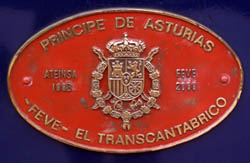 The last car in
the train was another service car. The public cars are of
antique vintage, lovingly refurbished with discreetly
integrated modern amenities like air conditioning. The
sleeping coaches are much newer, and ride on state of the
art, very quiet bogies. The train typically does not
travel while you are sleeping, although it does start
moving before breakfast on days where there is a lot of
ground to cover. Riding comfort is not a problem in spite
of the narrow gauge track.
The last car in
the train was another service car. The public cars are of
antique vintage, lovingly refurbished with discreetly
integrated modern amenities like air conditioning. The
sleeping coaches are much newer, and ride on state of the
art, very quiet bogies. The train typically does not
travel while you are sleeping, although it does start
moving before breakfast on days where there is a lot of
ground to cover. Riding comfort is not a problem in spite
of the narrow gauge track.
Accomodations are very private. Each sleeping coach
contains four suites, each with a double bed, individual
air conditioning, minibar, private bathroom with vanity,
toilet and a state of the art shower. Windows are treated
so that passerbys cannot peek in from outside during
daylight hours. Because this is a narrow gauge railway,
the width of the coaches is limited and the length of the
beds is limited accordingly. Travellers taller than six
feet may find the bed short.  The accommodation is
vast compared to typical sleeper train accommodations, but
cramped compared to the cabins on new cruise ships. If you
have ever bunked on a small boat it will feel very
spacious. Each suite comes with complimentary slippers,
robes and toilet kits. There is plenty of hot water. The
suites are cleaned, beds made, and towels refreshed every
day. There is room for bag storage under the bed, a small
full height hanging closet, a drawer, a space for shoes, a
small desk with a small safe above the minibar, and a
narrow shelf with a lip above the head of the bed. This
shelf is convenient for cameras, books and other small
items. The cabin light and individual reading lights can
be dimmed. There is one 220V electrical outlet near the
bed, and another one in the medicine cabinet above the
sink in the bathroom. We used the bathroom outlet to
charge a cell phone, and the bedroom outlet to charge our
digital camera and computer with no problem. There is also
an outlet at each table in the lounge and dining cars.
The accommodation is
vast compared to typical sleeper train accommodations, but
cramped compared to the cabins on new cruise ships. If you
have ever bunked on a small boat it will feel very
spacious. Each suite comes with complimentary slippers,
robes and toilet kits. There is plenty of hot water. The
suites are cleaned, beds made, and towels refreshed every
day. There is room for bag storage under the bed, a small
full height hanging closet, a drawer, a space for shoes, a
small desk with a small safe above the minibar, and a
narrow shelf with a lip above the head of the bed. This
shelf is convenient for cameras, books and other small
items. The cabin light and individual reading lights can
be dimmed. There is one 220V electrical outlet near the
bed, and another one in the medicine cabinet above the
sink in the bathroom. We used the bathroom outlet to
charge a cell phone, and the bedroom outlet to charge our
digital camera and computer with no problem. There is also
an outlet at each table in the lounge and dining cars.
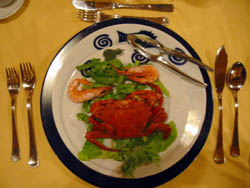 Food
FoodGastronomy is an important component of this tour. The meals are unhurried and vary in character, from country inn food as served to the pilgrims on their way to Santiago, to pretty gourmet dishes. The emphasis is on local or regional specialties and fresh ingredients. Since the train traverses several regions (Galicia, Asturias, Cantabria, Basque Country and Castille & León), this means that you are not likely to get the same dish twice. The menu is set for each meal, but each meal includes a succession of courses to satisfy different tastes. One lesson we learned early on our trip is that a full meal of delicious regional food for lunch and then dinner can be more than enough to satiate, especially after the buffet breakfast. However, after sitting down for a few minutes at each new table and sipping some complimentary wine, the appetite inexplicably tended to return just in time for the first course every time. On the other hand, some passengers just skipped a few dinners and helped themselves from a large fruit basket in the train's reading lounge.
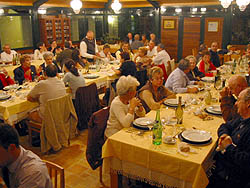 If you
have special dietary requirements, it is important to
indicate them at the time of reservation. Normally the
food consists of typical regional dishes, which include
meat, seafood, dairy products, etc. The ability of
restaurants to accommodate different diets may vary.
If you
have special dietary requirements, it is important to
indicate them at the time of reservation. Normally the
food consists of typical regional dishes, which include
meat, seafood, dairy products, etc. The ability of
restaurants to accommodate different diets may vary.
Breakfast is a buffet set up each of the two lounge cars on the train. Espresso is available. All lunches and dinners are in local restaurants, except for one dinner on the train. Since every lunch and dinner is in another restaurant, table arrangements vary from long inn tables to small tables for 6 to 12 people. This allows you to mix and interact with different people if you so desire. Note that in Spain many people smoke, and non smokers do tend to choose where they want to sit accordingly. Smokers are typically polite about this. The the lounge cars where breakfast is served are non smoking.
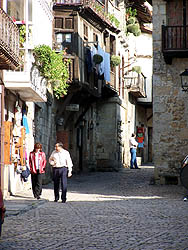 Fitness
FitnessThere are steps involved, and navigating the corridors on the train requires a minimum level of agility. However, if you can walk a few city blocks easily you will enjoy this train. Many of the excursions off the train involve some walking, especially since vehicle traffic is banned or restricted in the core of most Spanish cities. On our trip, a few passengers elected to pass on some excursions, or were content to just stay with the bus. The tours and train schedule are arranged to make this easy.
There are plenty of opportunity for walking. Early
morning jogging is also practical—as long as you
remember the scheduled departure time for the train.
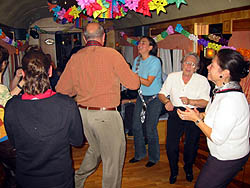 The dance floor in the pub car looks like it can also be
pressed into service for aerobics or floor work except of
course during evening entertainment or dancing.
The dance floor in the pub car looks like it can also be
pressed into service for aerobics or floor work except of
course during evening entertainment or dancing.
We strongly recommend that you use soft sided baggage that can easily be stowed under the bed. Protect fragile items in a hard sided container, but such a container should not exceed airplane carry-on size. Keep in mind that the bar in the hanging closet is only about 15 inches long.
You should take a small shoulder bag or daypack so you can keep valuables, prescription drugs, and other small necessities or very fragile items with you while the baggage is being transferred to and from the train. Note that you will typically be carrying this small bag on a walking tour a the end of the trip, so choose something small and light. Make sure this small bag is pickpocket-proof because you may be walking through crowded places.
The Transcantábrico trip includes
Return to the Transcantábrico main page
Transcantábrico itinerary, schedule and rates